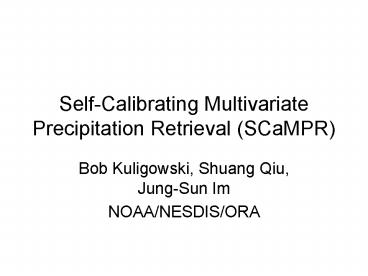SelfCalibrating Multivariate Precipitation Retrieval SCaMPR PowerPoint PPT Presentation
1 / 7
Title: SelfCalibrating Multivariate Precipitation Retrieval SCaMPR
1
Self-Calibrating Multivariate Precipitation
Retrieval (SCaMPR)
- Bob Kuligowski, Shuang Qiu, Jung-Sun Im
- NOAA/NESDIS/ORA
2
Theory / Schematic
- Algorithm Inputs (IR, MW, NWP)
- 6.9, 10.7, and 13.2-µm Tbs from GOES-12
- SSM/I rain rates from NRL
- AMSU rain rates from MSPPS (Ferraro)
- All GOES inputs are from GVAR feeds
- Algorithm Process (how the inputs are converted
to rainfall estimates) - Rain/no rain separation via discriminant analysis
- Rain rate estimation via stepwise linear
regression - IR Calibration Data Cube
- GOES inputs aggregated to SSM/I or AMSU
footprints plus SSM/I or AMSU rain rates - Most recent matched data used such that 5,000
raining points are available (nonraining points
are included, but the number does not matter)
3
SCaMPR Predictors
SCaMPR Predictands
GOES T6.9 µm
GOES T10.7 µm
GOES T13.3 µm
SSM/I Rain Rates
T10.7-T13.3
T10.7-T6.9
AMSU Rain Rates
S 0.568 (T10.7,min-217 K)
Derived Quantities
Gt-S (T10.7,avg-T10.7,min)-S
Aggregate to microwave footprint
Match predictor and predictand pixels (separate
sets for raining and non-raining predictor pixels)
Raining pixels
Dry pixels
Calibrate rain/no rain discrimination via
discriminant analysis
Calibrate rain rate estimation via multiple
regression
Apply to independent predictor data for rain rate
retrievals
4
Theory / Schematic
- Strengths and Weaknesses of Underlying
Assumptions - Only as reliable as the SSM/I and AMSU rain
rates SCaMPR will perform poorly where they
perform poorly - Differences between SSM/I and AMSU rain rates
make adjustments necessary before calibration - Currently calibrated for CONUS as a whole, but
geographic differences in Tb-rain rate
relationships are inducing time-varying biases in
SCaMPR rain rates - Balance of having a long enough training period
for statistically significant training, but a
short enough training period to capture
nonstationarity in relationships between
predictors and rain rate no objective way to
determine this
5
Theory / Schematic
- Planned Modifications / Improvements
- Currently transitioning from all-CONUS to
regional calibration - Soon to begin real-time ingest of NAM PW,
1000-700 hPa mean RH, convective EL computed from
T, q profile (already shown to have positive
impact on case studies) - Soon to begin real-time ingest of cloud-to-ground
lightning from National Lightning Detection
Network (NLDN)already shown to have positive
impact on case studies - Transition to global production planned for fall
6
Algorithm Output Information
- Spatial Resolution 4 km
- Spatial Coverage CONUS (2550N 125-65W)
- Update Frequency every 15 min
- Data Latency ???
- Source of Real-Time Data
- Soon to be made available on the Web (graphic
images only) as a link from the Flash Flood Web
page (http//www.orbit.nesdis.noaa.gov/smcd/emb/ff
)
7
Algorithm Output Information
- Source of Archive Data
- Limited online archive at http//www.orbit.nesdis.
noaa.gov/smcd/emb/ff/validation/validation.html - Offline CONUS archive back to November 2004
- Capability of Producing Retrospective Data (data
and resources required / available) - SSM/I and AMSU rain rates can be reproduced from
CLASS archive - GOES data available to December 2003 from CLASS
archive - Eta data available from ORA tape archive back to
1997

